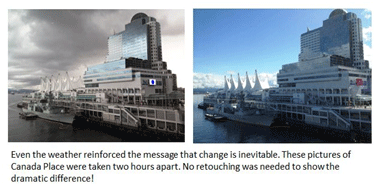Guest Post by Kim McCleary of the CFIDS Association of America
I had the tremendous opportunity to attend the 49th international conference on fundraising, hosted by the Association of Fundraising Professionals (AFP) in Vancouver, British Columbia. The conference drew 3,000 attendees, including 900 people from across Canada — the most ever. The jam-packed three-day agenda offered daily general sessions with nationally renowned speakers on cross-cutting issues in philanthropy and scores of education sessions given by experts on more specialized topics. As a new member of AFP but a veteran nonprofit CEO of 21 years, this was my first conference and I enjoyed learning from and with professionals dedicated to advancing a diverse spectrum of worthy causes.
Here are my top 10 impressions based on the sessions I attended during the conference and a one-day “CEO school” that I added as a pre-conference learning opportunity:
1. Fundraising isn’t driven by clever gimmicks, sophisticated mind tricks or high-pressure sales quotas, it’s about connecting donors to their dreams. Donors want to give to causes that inspire and motivate them, not according to your schedule of campaign deadlines and targets. Think of major gifts acquisition as a long-term courtship that has to unfold on its own schedule. It generally takes 6-24 months and 6-9 meaningful contacts to establish an individual’s trust to make a significant gift. At every level of giving, the donor is matching his/her values to the values of the organization so you must demonstrate and reinforce your values in every communication.
2. Measure what’s important. Most organizations are awash in data. Just because you can measure it, doesn’t mean you should measure it. Management should operate by a dashboard of three “dials” that regularly measure the organization’s impact. The Board should operate likewise, by a different set of three composite measures to make sure the organization is performing effectively. Measuring board performance is something we need to work on in the sector.
 3. Change is happening all around us; we need to lead it. Nonprofit leaders should be conscious of two kinds of change affecting their organizations: Horshin and Kaizen, to borrow from the Japanese. Horshin change is sudden, transformational change. It is driven from the top and often prompts feelings of excitement and fear among the organization’s stakeholders. Its high-risk nature can also generate increased commitment. Kaizen change is long-term change that occurs in small chunks. It often rises from the bottom up and is more predictable. The feelings it provokes are safety, control and sometimes boredom. In any change situation, you’ll find champions, considerers, converts, challengers and change-a-phobics. Be prepared for all of them.
3. Change is happening all around us; we need to lead it. Nonprofit leaders should be conscious of two kinds of change affecting their organizations: Horshin and Kaizen, to borrow from the Japanese. Horshin change is sudden, transformational change. It is driven from the top and often prompts feelings of excitement and fear among the organization’s stakeholders. Its high-risk nature can also generate increased commitment. Kaizen change is long-term change that occurs in small chunks. It often rises from the bottom up and is more predictable. The feelings it provokes are safety, control and sometimes boredom. In any change situation, you’ll find champions, considerers, converts, challengers and change-a-phobics. Be prepared for all of them.
4. Finding the right people can be a challenge, but it’s essential. Jim Collins writes about getting the “right people on the bus” as being the first step to go from good to great. That’s a challenge, particularly among fundraisers, when new research shows that the  demand for good fundraisers is so high that the average tenure is just 16 months. (Remember, it can take 6-24 months to position the ask for a major gift!)
demand for good fundraisers is so high that the average tenure is just 16 months. (Remember, it can take 6-24 months to position the ask for a major gift!)
5. Get good at video and infographics. Social media is here to stay and the only return-on-investment you might be able to measure is whether you’re around five years from now if you don’t serve constituents – especially millennials – who demand a more dynamic, two-way dialogue than traditional media provides. Video is the most eagerly consumed media, with photos placing second. Whatever text you write better be good and concise.
6. Tell the truth. Scandals in the nonprofit and corporate sectors have driven a desire for greater transparency. Be candid about failures, especially when they involve innovation. Donors will appreciate your honesty and many will understand that taking risks sometimes leads to disappointment. If your organization is performing poorly and consistently not meeting its objectives, be prepared to explain why and possibly to change leadership. There are few acceptable excuses for consistently poor performance.
7. Donors don’t care about what you’re doing; they care about what impact you’re having. There are lots of outputs you can describe in lengthy annual reports and publications. What changes minds and engages hearts is the story of one individual served by your agency or one condition changed by your organization. Find that story and tell it well. Everywhere. Make every person connected to your organization an ambassador for your cause by sharing stories, not statistics.
8. A clear and compelling statement of the organization’s value is crucial. Whether you think about it in terms of the “burning platform” statement, the change imperative, the value proposition or the market position, you MUST be able to communicate clearly why your organization exists and why others should support it. And you better do it quickly and memorably. Attention spans are getting shorter.
 9. Dream big. Close your eyes and imagine holding between your hands a box that contains all the dreams you have for your organization. Are your hands shoulder-width distance from one another? Yep. That’s the standard aspiration. Stretch them as far apart as your arms will reach. That’s the size of the dream you need to embrace and pursue. If you can’t dream that big, find another line of work.
9. Dream big. Close your eyes and imagine holding between your hands a box that contains all the dreams you have for your organization. Are your hands shoulder-width distance from one another? Yep. That’s the standard aspiration. Stretch them as far apart as your arms will reach. That’s the size of the dream you need to embrace and pursue. If you can’t dream that big, find another line of work.
10. The most important thing we can say to people who support us is “thank you.” Nonprofits spend too much time thinking about and taking action to ask people to meet their needs and not enough time and energy expressing gratitude to those who do. Our communication with donors should be 80 percent listening, asking open-ended questions that allow the donor to express their values and dreams for making a difference. Matching the donor’s philanthropic vision to the needs of the institution is crucial to receiving the gift. Being the grateful conduit that connects that individual to his/her dreams is a pillar of building long-term relationships with donors at all giving levels. Gratitude, not gimmicks.
It’s humbling to think of the opportunity we have as nonprofit professionals to change and shape a better world. We have an obligation to pursue that charge with excellence; education and professional development opportunities like the AFP conference help us do that. I am grateful for the experiences I had and the people I met in Vancouver.
Kim McCleary is president & CEO of the CFIDS Association of America and has served as the organization’s chief staff executive since 1991. Although Kim has held the same position for 21 years, she finds that every day presents new opportunities and that the work she does for the Association has changed over time to meet the diverse needs of people living with chronic fatigue syndrome (CFS, also called CFIDS or ME/CFS) and an evolving organization. You can learn more about CFS and the Association’s work at www.Research1st.com or @PlzSolveCFS.






